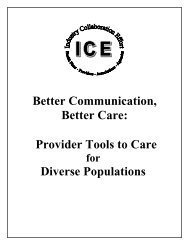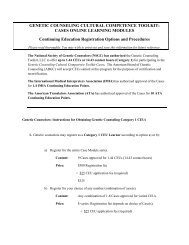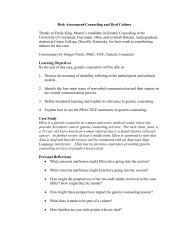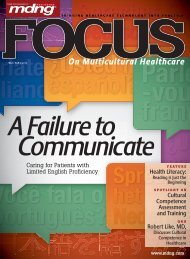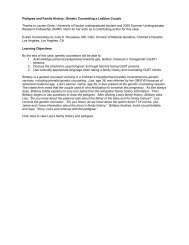Advanced Effective Communication, Cultural Competence, and ...
Advanced Effective Communication, Cultural Competence, and ...
Advanced Effective Communication, Cultural Competence, and ...
Create successful ePaper yourself
Turn your PDF publications into a flip-book with our unique Google optimized e-Paper software.
Introduction<br />
Every patient that enters the hospital has a unique set of<br />
needs—clinical symptoms that require medical attention <strong>and</strong><br />
issues specific to the individual that can affect his or her care.<br />
As patients move along the care continuum, it is important<br />
for hospitals to be prepared to identify <strong>and</strong> address not just<br />
the clinical aspects of care, but also the spectrum of each<br />
patient’s demographic <strong>and</strong> personal characteristics.<br />
The nation’s hospitals traditionally focus on meeting the<br />
clinical needs of their patients; they seek to prevent errors <strong>and</strong><br />
avoid inaccuracies that negatively impact the safety <strong>and</strong> quality<br />
of care. However, patients also have specific characteristics <strong>and</strong><br />
nonclinical needs that can affect the way they view, receive,<br />
<strong>and</strong> participate in health care. A growing body of research<br />
documents that a variety of patient populations experience<br />
decreased patient safety, poorer health outcomes, <strong>and</strong> lower<br />
quality care based on race, ethnicity, language, disability, <strong>and</strong><br />
sexual orientation [1-4]. As cultural, communication, mobility,<br />
<strong>and</strong> other basic patient needs go unmet, hospitals will<br />
continue to put themselves <strong>and</strong> their patients at risk for<br />
negative consequences. To improve the overall safety <strong>and</strong><br />
quality of care provided in hospitals nationwide, health care<br />
organizations should aspire to meet the unique needs of their<br />
patients—patient by patient.<br />
The Joint Commission has made several efforts, both past<br />
<strong>and</strong> present, to better underst<strong>and</strong> individual patients’ needs<br />
<strong>and</strong> to provide guidance for organizations working to address<br />
those needs. The Joint Commission first focused on studying<br />
language, culture, <strong>and</strong> health literacy issues, but later<br />
exp<strong>and</strong>ed its scope of work to include the broader issues of<br />
effective communication, cultural competence, <strong>and</strong> patient<strong>and</strong><br />
family-centered care (see Table 1, page 2). No longer<br />
considered to be simply a patient’s right, effective<br />
communication is now accepted as an essential component<br />
of quality care <strong>and</strong> patient safety [5,6]. Additional studies<br />
show that incorporating the concepts of cultural competence<br />
<strong>and</strong> patient- <strong>and</strong> family-centeredness into the care process<br />
can increase patient satisfaction <strong>and</strong> adherence with<br />
treatment [7,8].<br />
Terminology<br />
A clear underst<strong>and</strong>ing of the concepts addressed in the<br />
Roadmap for Hospitals will ensure that the hospital is<br />
approaching effective communication, cultural competence,<br />
<strong>and</strong> patient- <strong>and</strong> family-centered care from the same<br />
perspective. The following terms are used frequently<br />
throughout this document.<br />
• <strong>Effective</strong> communication The successful joint<br />
establishment of meaning wherein patients <strong>and</strong> health care<br />
providers exchange information, enabling patients to<br />
participate actively in their care from admission through<br />
discharge, <strong>and</strong> ensuring that the responsibilities of both<br />
patients <strong>and</strong> providers are understood. To be truly<br />
effective, communication requires a two-way process<br />
(expressive <strong>and</strong> receptive) in which messages are<br />
negotiated until the information is correctly understood<br />
by both parties. Successful communication takes place<br />
only when providers underst<strong>and</strong> <strong>and</strong> integrate the<br />
information gleaned from patients, <strong>and</strong> when patients<br />
comprehend accurate, timely, complete, <strong>and</strong> unambiguous<br />
messages from providers in a way that enables them to<br />
participate responsibly in their care.<br />
• <strong>Cultural</strong> competence The ability of health care providers<br />
<strong>and</strong> health care organizations to underst<strong>and</strong> <strong>and</strong> respond<br />
effectively to the cultural <strong>and</strong> language needs brought by<br />
the patient to the health care encounter. <strong>Cultural</strong><br />
competence requires organizations <strong>and</strong> their personnel to<br />
do the following: (1) value diversity; (2) assess themselves;<br />
(3) manage the dynamics of difference; (4) acquire <strong>and</strong><br />
institutionalize cultural knowledge; <strong>and</strong> (5) adapt to<br />
diversity <strong>and</strong> the cultural contexts of individuals <strong>and</strong><br />
communities served [9].<br />
• Patient- <strong>and</strong> family-centered care An innovative<br />
approach to plan, deliver, <strong>and</strong> evaluate health care that is<br />
grounded in mutually beneficial partnerships among<br />
1



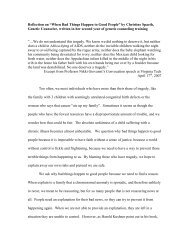
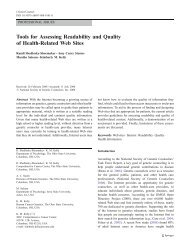

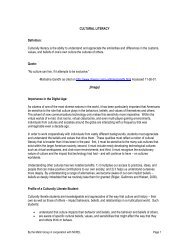
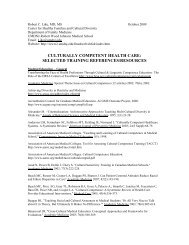

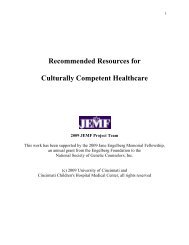

![Breaking Bad News PPT[1] - Genetic Counseling Cultural ...](https://img.yumpu.com/35003134/1/190x146/breaking-bad-news-ppt1-genetic-counseling-cultural-.jpg?quality=85)
